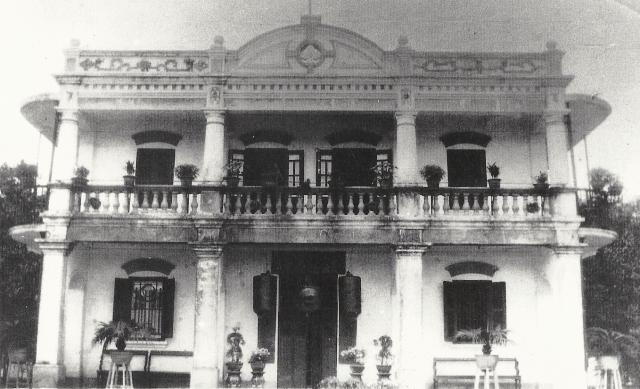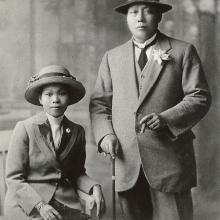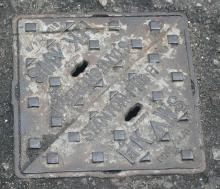Can anyone identify or recognise this house which was apparently owned by my greatgrandfather Chu Ting Cheung until he died in 1930? My mother's birth certificate says she was born in 1936 in Wan Tau Kok although they never lived in this house. I think the photo was taken in 1936 or 1937. She and her brothers used to visit and play there at weekends. My grandfather was Chu Yan Kit and he had sisters who lived in Tai Po Market.




Comments
With refer to your post ,
With reference to your post , this is the photo you are looking for , this is a photo of Tai Po in the late 60s or early 70s where Wan Tau Kok in the background .
Tai Po in the late 60s
1911.jpg, by Pw Chu
Wan Tau Kok
Let’s have a closer look at Wan Tau Kok .
Tai Wo Yuen
In this photo , the black circle is possibly the house owned by your great grandfather Chu Ting Cheung . The house then was donated to Lok Sin Tong In 1976 by your grandfather Chu Yan Kit where a Home For the Aged was built to memorise Chu Ting Cheung
It is a Church in the Red Circle which was donated by Chu Yan Kit in 1958 to the Catholic . The Catholic church was built in 1961 .
Chu family
Thank you so much - this has opened up a new seam of information about my family which has helped me make sense of a number of rumours which I took to be myths. Following your lead I found this book about the Church in Tai Po Market which confirms and amplifies on what you say http://taipo.catholic.org.hk/wp-content/uploads/2013/05/150+50_Publicati.... I did actually visit Hong Kong in March and even visited and took photos of this Church as I assumed it had been donated by my grandfather. I then found out about the land at Fanling which was donated in 1952.
My next 3 questions are:- 1) What does the blue circle represent? 2) Are you (Pw Chu) a descendent of Chu Yan Kit and therefore a relative of mine? 3) If so can we please exchange email addresses? 4) Would admin approve of my creating an album of old Chu family and property photos as there are a number of unidentified people which others may be able to help with?
Tai Po Kindergarten
The blue circle is Tai Po Kindergarten , the same building in the bottom left ,this is the Icon of Tai Po in the early 50s . I use this photo to talk about the history of Tai Po in Facebook group .
My family land was bought from Chu Yan Kit in the 60s , I have nothing related to Mr. CHU’s family , I just interested in the history of Tai Po where I have lived for 30 years .
Chu family & Tai Po history
Kim,
yes please, it will be good to see your family history photos. Please could you let me know the years covered, then I'll make an album named "19xx-19yy Chu family photos".
PW,
Thanks for your explanation, it isn't an area I know well. Looking at the modern map, is the new road in front of the circles on your photo the Wan Tau Street? It seems to have the same bends.
Regards, David
The CHU’s family
David,
There is a lot of changes of Tai Po after the 80s , the Wan Tau Street is still the same , and it is far more better looking now .
I am Looking forward to seeing the CHU’s family album . There is a lot of stories to tell about the Tai Wo Yuen and the CHU’s family .
Chu family
Hi David,
Many thanks for this. Most of the photos will be from between 1920 and 1955.
I would like to pay something towards this site as I have found it so helpful and fascinating. I am in the UK but do have friends in Hong Kong who might be able to trasnfer some funds in local currency if that's the only way.
Best wishes
Kim
Chu family stories
Dear Pw,
I am so glad that you have some stories about my family - are these from your own memory or from an older relative? I shall try to annotate each photo so that if you are able you can please add some more detail.
You mention that your family bought property from Chu Yan Kit. Can you tell me which land that was? So far I know that he donated the land for St Joseph's Church in Fanling and that the Tai Po property (red and black circles) was split between the current Church in Tai Po Market and the care home in memory of his father Chu Ting Cheung. Then there was the land in Fanling that was requisitioned by the British Army in 1949 presumably to protect the border with China.
This is very exciting for my generation who grew up with very little knowledge about our ancestors. I'd still love to meet you and anyone who has a living memory of my grandfather's generation. I'll try to befriend you on Facebook too.
Many thanks
Kim
Tai Po Market
I have extracted the relevant text from the book which I found on the Tai Po Church website.
It was clear that acquiring a new church-site such that a new, and much larger, church could be built was becoming a very urgent priority. The rst attempt to acquire private land to build a new church (the Bishop having given up all thoughts of acquiring land from the Government) came in 1955 (Pl.27 pg.220). The Chu family had built a large villa-complex on the west-facing slopes of the District Of ce hill (Flagstaff Hill), probably a little after 1920. The family had also bought land at Fanling. In 1951-1952, the family donated the Fanling land to the Diocese, and the Fanling church and residence was built on this land. In 1955 the family, then headed by Chu Yan-kit, offered the Diocese the land at Tai Po. Chu Yan-kit wanted this land to be used by the Diocese to build an Industrial Secondary School and church, in memory of his recently deceased father. Unfortunately, the Education Department refused to consider sponsoring any such school (the Bishop wrote that the New Territories Inspector of Schools had said that there was “not theslightest hope that such a school would receive any subsidy from the Government”), and the Bishop could see no way that the Diocese would be able to meet the recurrent costs of the school, and so he had to decline the offer. The Bishop wrote to Chu Yan-Kit:
Three years later, in 1958, such a further opportunity did arise. It was intimated by the Education Department that a Primary School would be able to get a Government subsidy to cover the running costs. The Chu family were again approached for land. The family, by then headed by Chu Ting-cheong acting as Trustee for Chu Yan-kit, agreed to sell the northern half of the site that had been offered for a Middle School in 1955. The Diocese accordingly bought eight plots of agricultural land (these had been used as the garden of the villa), and the site of the northern of the two Chu family villa-buildings on the site (14th February 1958). The price of the villa-building was set at $42,195. It is the general belief among those who were resident in Tai Po at the time that this sum was well below the market-price, and represents in part a donation by the Chu family. The southern part of the site offered in 1955 for the Middle School, including the second Chu family villa building, was sold at the same time (and again, it is believed, at well below the market price) to the Lok Sin Tong for construction of an old-folks home.
The villa site thus bought by the Diocese was too small for the purpose, and could not have been used to build a large enough church. The Diocese thus sought District Of ce consent to convert two of the agricultural lots to building lots, so that a larger building could be built. This was agreed on 15th December, 1958, with the amalgamated lots coming to 8,439 square feet, as against the old lot of 4110 square feet. The District Of ce imposed a new restrictive condition on the site (it could only be used to construct a church, which could only occupy 50% of the lot, and which could never be used for any other purposes than as a church), but none the less charged the full conversion premium for their consent ($19,717.53). The old 1920s villa was demolished, and a ne new church built on the site (constructed, and opened for services in 1961) (Pl.28 and Pl.29 pg.220), which is the one still in use today, and the Ap Mo Liu Church on the main road could be at last closed. The agricultural land included in this sale is today’s church car-park. Between 1961 and the opening of Wan Tau Street to traffic in 1965, access to the new church was by a footpath from the access road to the District Office. (Pl.30 pg.220)
The land bought in 1958 from the Chu family had awkward boundaries, and was intersected by a small strip of Crown land. In order to regularise this situation, all the lots were involved in a Surrender-and-Regrant arrangement in 1973: the lots were surrendered to Government, and then granted back as a single new lot with regularised boundaries. The area permitted to be built over was not, however, increased. The District Office charged $3,834 as the fee for this arrangement.
Chu Yan Kit
Hi Kim ,
Chu Yan Kit , a successful businessman and landlord , he owned a lot of agricutural land somewhere in Shui Wai Village , which was not far away from Tai Po Market.
Mr. Chu offered my father the whole lot of land , which was about hundred thousand square feet , but my father only bought ten thousand sq. ft. in the early 60s to build the house there . The price at that time was $ 1 per sq. ft. . All the land was resumed by government in early 80s to make way for housing .
Facebook
There is only one PW Chu - is that the name you use?
No
No
Tai Po
Kim - great photos, many thanks for sharing, I too have an interest in Tai Po history because I lived there for several years includsing directly opposite the land you are interested in. Although the buildings have been replaced, much of the old terracing on the slope seems to have been retained.
PW's group on facebook can be found here: https://www.facebook.com/groups/taipoop/
It's a fantastic group with lots of old photos and lots of people sharing memories (though usually in Chinese for obvious reasons).
With regards to the book on the history of the Catholic church in HK, the author Dr Patrick Hase, may be contactable through various emails (none of which I have though) as he still lives in Tai Po and retains a personal and professional interest in the history of the area. The book used to be avaialble in hard copy free from the church, but I'm not sure how many copies are left (if any) considering it was published a few years ago now.
Regards
Phil
Chu family
Hi Kim,
I've made the gallery, and moved this photo to it: 1920s-1950s Chu family photos
I can see you've already got the hang of "Person" pages. The other type of page that will be handy is the "Place". I've made one for the church mentioned above: http://gwulo.com/node/32216
Thanks for your offer of support. There are a couple of options, a monthly payment via Patreon, or a one-time payment via Paypal. Both accept UK credit cards.
Regards, David
Paypal
Hi David,
I tried out the paypal option so it should have come to Gwulo. Many thanks to you and others who have been so very helpful with your suggestions. Since my photographs are of people who have long since died I doubt whether they will jog any memories but the information about the land has been fascinating. Are you able to give me a link to the English language archives of the local paper as I can't access anything from the 1930s? I did go to the Library in Moreton Terrace in March but had much less idea of dates and key words.
Best wishes
Kim
I assume that you are the
I assume that you are the same person whose blog I read and who gave Patrick Hase the old photo for his book. All roads seem to lead to Rome or in this case to Tai Po Market! I have joined PW's group but the Facebook automatic translations are sometimes quite bizarre.
Best wishes
Kim
Paypal & newspapers
Hi Kim,
Thanks for your support via Paypal, much appreciated.
The people pages will likely take longer to get answers, but it's good to post them up and then let Google bring in people searching for the same names.
See an example of searching the online newspapers at http://gwulo.com/node/23672 and also check the list of resources at http://gwulo.com/node/9374
Regards, David
Tai Po
Hi Kim
Yes, it was my father-in-law's photo that was in the book. Sadly it wasn't printed in a big enough size to see the detail - I think Dr Hase had asked for it to be blown up somewhat but it didn't happen for whatever reason. You can see a bigger version here: https://flic.kr/p/5wsp4R
It does pay to have a little bit of Chinese knowledge, but there are some people in the group (such as PW) who obviously speak and write excellent English. I'm sure if you ever need a proper translation then all you need to do is add a comment and someone will oblige.
Cheers
Phil